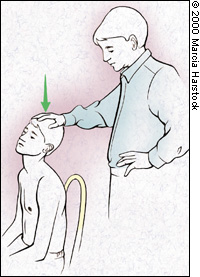
Am Fam Physician. 2000;61(10):3079-3088
This is Part I of a two-part article on clinical evaluation of the painful shoulder. Part II, “Acute and Chronic Injuries,” will appear in the next issue of AFP.
Family physicians need to understand diagnostic and treatment strategies for common causes of shoulder pain. We review key elements of the history and physical examination and describe maneuvers that can be used to reach an appropriate diagnosis. Examination of the shoulder should include inspection, palpation, evaluation of range of motion and provocative testing. In addition, a thorough sensorimotor examination of the upper extremity should be performed, and the neck and elbow should be evaluated.
Shoulder pain is a common complaint in family practice patients. The unique anatomy and range of motion of the glenohumeral joint can present a diagnostic challenge, but a proper clinical evaluation usually discloses the cause of the pain.
Anatomy
The shoulder is composed of the humerus, glenoid, scapula, acromion, clavicle and surrounding soft tissue structures. The shoulder region includes the glenohumeral joint, the acromioclavicular joint, the sternoclavicular joint and the scapulothoracic articulation (Figure 1a). The glenohumeral joint capsule consists of a fibrous capsule, ligaments and the glenoid labrum. Because of its lack of bony stability, the glenohumeral joint is the most commonly dislocated major joint in the body. Glenohumeral stability is due to a combination of ligamentous and capsular constraints, surrounding musculature and the glenoid labrum. Static joint stability is provided by the joint surfaces and the capsulolabral complex, and dynamic stability by the rotator cuff muscles and the scapular rotators (trapezius, serratus anterior, rhomboids and levator scapulae).
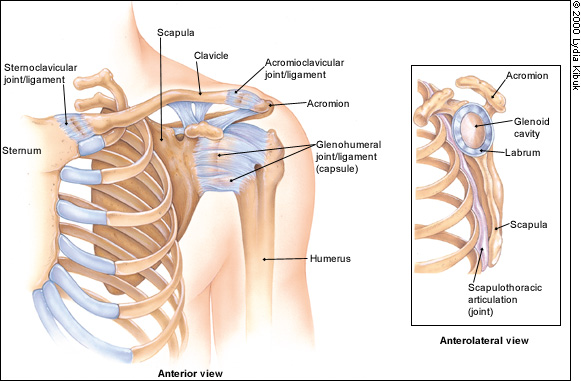
The rotator cuff is composed of four muscles: the supraspinatus, infraspinatus, teres minor and subscapularis (Figure 1b). The subscapularis facilitates internal rotation, and the infraspinatus and teres minor muscles assist in external rotation. The rotator cuff muscles depress the humeral head against the glenoid. With a poorly functioning (torn) rotator cuff, the humeral head can migrate upward within the joint because of an opposed action of the deltoid muscle.
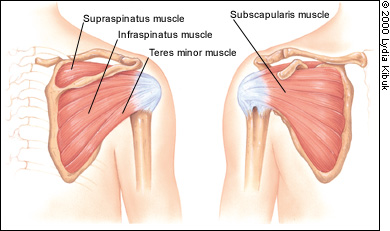
Scapular stability collectively involves the trapezius, serratus anterior and rhomboid muscles. The levator scapular and upper trapezius muscles support posture; the trapezius and the serratus anterior muscles help rotate the scapula upward, and the trapezius and the rhomboids aid scapular retraction.
History
A complete history begins with the patient's age, dominant hand and sport or work activity. It is important to assess whether the injury prevents or hampers normal work activities, hobbies and sports. The patient should be asked about shoulder pain, instability, stiffness, locking, catching and swelling. Stiffness or loss of motion may be the major symptom in patients with adhesive capsulitis (frozen shoulder), dislocation or glenohumeral joint arthritis. Pain with throwing (such as pitching a baseball) suggests anterior glenohumeral instability. Patients who complain of generalized joint laxity often have multidirectional glenohumeral instability.
Distinguishing between an acute and a chronic problem is diagnostically helpful (Table 1). For example, a history of acute trauma to the shoulder with the arm abducted and externally rotated strongly suggests shoulder subluxation or dislocation and possible glenoid labral injury. In contrast, chronic pain and loss of passive range of motion suggest frozen shoulder or tears of the rotator cuff.
| Finding | Probable diagnosis |
|---|---|
| Scapular winging, trauma, recent viral illness | Serratus anterior or trapezius dysfunction |
| Seizure and inability to passively or actively rotate affected arm externally | Posterior shoulder dislocation |
| Supraspinatus/infraspinatus wasting | Rotator cuff tear; suprascapular nerve entrapment |
| Pain radiating below elbow; decreased cervical range of motion | Cervical disc disease |
| Shoulder pain in throwing athletes; anterior glenohumeral joint pain and impingement | Glenohumeral joint instability |
| Pain or “clunking” sound with overhead motion | Labral disorder |
| Nighttime shoulder pain | Impingement |
| Generalized ligamentous laxity | Multidirectional instability |
Once the location, quality, radiation, and aggravating and relieving factors of the shoulder pain have been established, the possibility of referred pain should be excluded. Neck pain and pain that radiates below the elbow are often subtle signs of a cervical spine disorder that is mistaken for a shoulder problem.
The patient should be asked about paresthesias and muscle weakness. Pneumonia, cardiac ischemia and peptic ulcer disease can present with shoulder pain. A history of malignancy raises the possibility of metastatic disease. The patient should be asked about previous corticosteroid injections, particularly in the setting of osteopenia or rotator cuff tendon atrophy.
Physical Examination
A complete physical examination includes inspection and palpation, assessment of range of motion and strength, and provocative shoulder testing for possible impingement syndrome and glenohumeral instability. The neck and the elbow should also be examined to exclude the possibility that the shoulder pain is referred from a pathologic condition in either of these regions.
INSPECTION
The physical examination includes observing the way the patient moves and carries the shoulder. The patient should be properly disrobed to permit complete inspection of both shoulders. Swelling, asymmetry, muscle atrophy, scars, ecchymosis and any venous distention should be noted. Deformity, such as squaring of the shoulder that occurs with anterior dislocation, can immediately suggest a diagnosis. Scapular “winging,” which can be associated with shoulder instability and serratus anterior or trapezius dysfunction, should be noted. Atrophy of the supraspinatus or infraspinatus should prompt a further work-up for such conditions as rotator cuff tear, suprascapular nerve entrapment or neuropathy.
PALPATION
Palpation should include examination of the acromioclavicular and sternoclavicular joints, the cervical spine and the biceps tendon. The anterior glenohumeral joint, coracoid process, acromion and scapula should also be palpated for any tenderness and deformity.
RANGE-OF-MOTION TESTING
Because the complex series of articulations of the shoulder allows a wide range of motion, the affected extremity should be compared with the unaffected side to determine the patient's normal range. Active and passive ranges should be assessed. For example, a patient with loss of active motion alone is more likely to have weakness of the affected muscles than joint disease.
Shoulder abduction involves the glenohumeral joint and the scapulothoracic articulation. Glenohumeral motion can be isolated by holding the patient's scapula with one hand while the patient abducts the arm. The first 20 to 30 degrees of abduction should not require scapulothoracic motion. With the arm internally rotated (palm down), abduction continues to 120 degrees. Beyond 120 degrees, full abduction is possible only when the humerus is externally rotated (palm up).
The Apley scratch test is another useful maneuver to assess shoulder range of motion (Figure 2). In this test, abduction and external rotation are measured by having the patient reach behind the head and touch the superior aspect of the opposite scapula. Conversely, internal rotation and adduction of the shoulder are tested by having the patient reach behind the back and touch the inferior aspect of the opposite scapula. External rotation should be measured with the patient's arms at the side and elbows flexed to 90 degrees.
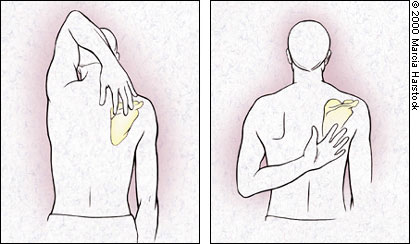
EVALUATING THE ROTATOR CUFF
In evaluating the rotator cuff, the patient's affected extremity should always be compared with the unaffected side to detect subtle differences in strength and motion. A key finding, particularly with rotator cuff problems, is pain accompanied by weakness. True weakness should be distinguished from weakness that is due to pain. A patient with subacromial bursitis with a tear of the rotator cuff often has objective rotator cuff weakness caused by pain when the arm is positioned in the arc of impingement. Conversely, the patient will have normal strength if the arm is not tested in abduction.1
The supraspinatus can be tested by having the patient abduct the shoulders to 90 degrees in forward flexion with the thumbs pointing downward. The patient then attempts to elevate the arms against examiner resistance (Figure 3). This is often referred to as the “empty can” test.
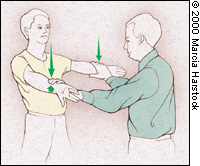
Next, with the patient's arms at the sides, the patient flexes both elbows to 90 degrees while the examiner provides resistance against external rotation (Figure 4). This maneuver is used to evaluate the function of the infraspinatus and teres minor muscles, which are mainly responsible for external rotation.
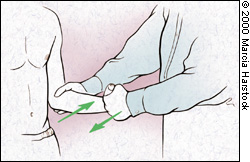
Subscapularis function is assessed with the lift-off test. The patient rests the dorsum of the hand on the back in the lumbar area. Inability to move the hand off the back by further internal rotation of the arm suggests injury to the subscapularis muscle.2 In one study, the investigators noted that only a few of the patients with confirmed subscapularis ruptures actually demonstrated a positive result on the lift-off test; the remainder could not complete the test because of pain.3
A modified version of the lift-off test is useful in a patient who cannot place the hand behind the back. In this version, the patient places the hand of the affected arm on the abdomen and resists the examiner's attempts to externally rotate the arm.
Provocative Testing
Provocative tests provide a more focused evaluation for specific problems and are typically performed after the history and general examination have been completed (Table 2).
| Test | Maneuver | Diagnosis suggested by positive result |
|---|---|---|
| Apley scratch test | Patient touches superior and inferior aspects of opposite scapula | Loss of range of motion: rotator cuff problem |
| Neer's sign | Arm in full flexion | Subacromial impingement |
| Hawkins' test | Forward flexion of the shoulder to 90 degrees and internal rotation | Supraspinatus tendon impingement |
| Drop-arm test | Arm lowered slowly to waist | Rotator cuff tear |
| Cross-arm test | Forward elevation to 90 degrees and active adduction | Acromioclavicular joint arthritis |
| Spurling's test | Spine extended with head rotated to affected shoulder while axially loaded | Cervical nerve root disorder |
| Apprehension test | Anterior pressure on the humerus with external rotation | Anterior glenohumeral instability |
| Relocation test | Posterior force on humerus while externally rotating the arm | Anterior glenohumeral instability |
| Sulcus sign | Pulling downward on elbow or wrist | Inferior glenohumeral instability |
| Yergason test | Elbow flexed to 90 degrees with forearm pronated | Biceps tendon instability or tendonitis |
| Speed's maneuver | Elbow flexed 20 to 30 degrees and forearm supinated | Biceps tendon instability or tendonitis |
| “Clunk” sign | Rotation of loaded shoulder from extension to forward flexion | Labral disorder |
NEER'S TEST
Neer's impingement sign is elicited when the patient's rotator cuff tendons are pinched under the coracoacromial arch. The test4 is performed by placing the arm in forced flexion with the arm fully pronated (Figure 5). The scapula should be stabilized during the maneuver to prevent scapulothoracic motion. Pain with this maneuver is a sign of subacromial impingement.
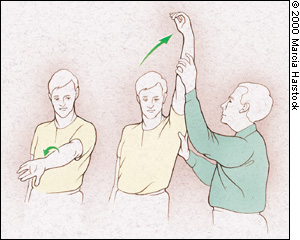
HAWKINS' TEST
The Hawkins' test is another commonly performed assessment of impingement.5 It is performed by elevating the patient's arm forward to 90 degrees while forcibly internally rotating the shoulder (Figure 6). Pain with this maneuver suggests subacromial impingement or rotator cuff tendonitis. One study6 found Hawkins' test more sensitive for impingement than Neer's test.
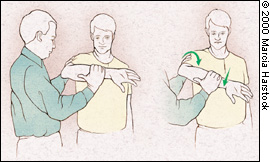
DROP-ARM TEST
A possible rotator cuff tear can be evaluated with the drop-arm test. This test is performed by passively abducting the patient's shoulder, then observing as the patient slowly lowers the arm to the waist. Often, the arm will drop to the side if the patient has a rotator cuff tear or supraspinatus dysfunction. The patient may be able to lower the arm slowly to 90 degrees (because this is a function mostly of the deltoid muscle) but will be unable to continue the maneuver as far as the waist.
CROSS-ARM TEST
Patients with acromioclavicular joint dysfunction often have shoulder pain that is mistaken for impingement syndrome. The cross-arm test isolates the acromioclavicular joint. The patient raises the affected arm to 90 degrees. Active adduction of the arm forces the acromion into the distal end of the clavicle (Figure 7). Pain in the area of the acromioclavicular joint suggests a disorder in this region.
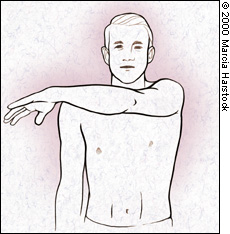
Instability Testing
The tests described in this section are useful in evaluating for glenohumeral joint stability. Because the shoulder is normally the most unstable joint in the body, it can demonstrate significant glenohumeral translation (motion). Again, the uninvolved extremity should be examined for comparison with the affected side.7,8
APPREHENSION TEST
The anterior apprehension test is performed with the patient supine or seated and the shoulder in a neutral position at 90 degrees of abduction. The examiner applies slight anterior pressure to the humerus (too much force can dislocate the humerus) and externally rotates the arm (Figure 8). Pain or apprehension about the feeling of impending subluxation or dislocation indicates anterior glenohumeral instability.
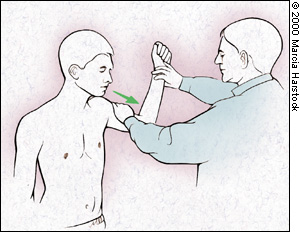
RELOCATION TEST
The relocation test is performed immediately after a positive result on the anterior apprehension test. With the patient supine, the examiner applies posterior force on the proximal humerus while externally rotating the patient's arm. A decrease in pain or apprehension suggests anterior glenohumeral instability.
YERGASON TEST
Patients with rotator cuff tendonitis frequently have concomitant inflammation of the biceps tendon. The Yergason test is used to evaluate the biceps tendon.9 In this test, the patient's elbow is flexed to 90 degrees with the thumb up. The examiner grasps the wrist, resisting attempts by the patient to actively supinate the arm and flex the elbow (Figure 9). Pain with this maneuver indicates biceps tendonitis.
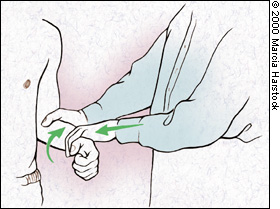
SPEED'S MANEUVER
Speed's maneuver is used to examine the proximal tendon of the long head of the biceps. The patient's elbow is flexed 20 to 30 degrees with the forearm in supination and the arm in about 60 degrees of flexion. The examiner resists forward flexion of the arm while palpating the patient's biceps tendon over the anterior aspect of the shoulder.
SULCUS SIGN
With the patient's arm in a neutral position, the examiner pulls downward on the elbow or wrist while observing the shoulder area for a sulcus or depression lateral or inferior to the acromion. The presence of a depression indicates inferior translation of the humerus and suggests inferior glenohumeral instability (Figure 10). The examiner should remember that many asymptomatic patients, especially adolescents, normally have some degree of instability.10
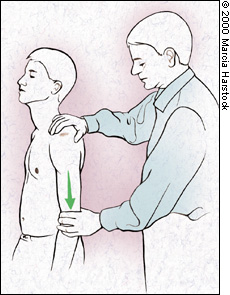
POSTERIOR APPREHENSION AND INSTABILITY
Posterior instability of the shoulder can be assessed by using a simple test.11 With the patient supine or sitting, the examiner pushes posteriorly on the humeral head with the patient's arm in 90 degrees of abduction and the elbow in 90 degrees of flexion.
‘CLUNK’ SIGN
Glenoid labral tears are assessed with the patient supine. The patient's arm is rotated and loaded (force applied) from extension through to forward flexion. A “clunk” sound or clicking sensation can indicate a labral tear even without instability.12
Cervical Disc Disease
No physical examination in a patient with shoulder pain is complete without excluding cervical spine disease. Referred or radicular pain from disc disease should be considered in patients who have shoulder pain that does not respond to conservative treatment. The patient should be questioned about neck pain and previous neck injury, and the examiner should note whether pain worsens with turning of the neck, which suggests disc disease. Pain that originates from the neck or radiates past the elbow is often associated with a neck disorder.
Plain film is a useful screening tool for degenerative cervical disc disease. Further work-up and imaging studies depend on the differential diagnosis and the treatment plan.
SPURLING'S TEST
In a patient with neck pain or pain that radiates below the elbow, a useful maneuver to further evaluate the cervical spine is Spurling's test. The patient's cervical spine is placed in extension and the head rotated toward the affected shoulder. An axial load is then placed on the spine (Figure 11). Reproduction of the patient's shoulder or arm pain indicates possible cervical nerve root compression and warrants further evaluation of the bony and soft tissue structures of the cervical spine.
